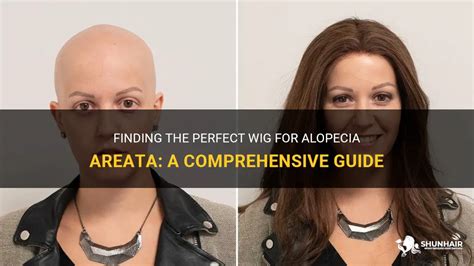Understanding Alopecia
Alopecia is a condition characterized by hair loss that can range from mild thinning to complete baldness. It can affect people of all ages, genders, and ethnicities. The most common type of alopecia is androgenetic alopecia, also known as male or female pattern baldness. Alopecia areata, a condition that causes patchy hair loss, is another prevalent form.

The Role of Wigs in Alopecia
Wigs offer a discreet and versatile solution for individuals experiencing hair loss due to alopecia. They can help restore confidence, enhance self-esteem, and provide a sense of normalcy. With advancements in hair technology, wigs have become increasingly natural-looking and comfortable to wear.
Choosing the Right Wig for Alopecia
Selecting the perfect wig for alopecia involves several key considerations:
1. Hair Type and Texture: Match the texture and wave pattern of your natural hair to ensure a seamless blend.
2. Color and Length: Choose a color that complements your skin tone and a length that suits your style and face shape.
3. Cap Construction: Monofilament, lace front, and hand-tied caps offer various levels of comfort, durability, and natural-looking part lines.
Types of Wigs for Alopecia
Synthetic Wigs: Affordable, durable, and easy to style. Heat-resistant synthetic wigs provide versatile options.
Human Hair Wigs: Luxurious, natural-looking wigs made from real human hair. They can be styled with heat and dyed to match your hair color.
Lace Front Wigs: Mimic the natural hairline with a sheer lace front. They create a realistic and undetectable transition.
Medical Wigs: Specially designed for individuals undergoing chemotherapy or radiation therapy. They are lightweight, breathable, and made from hypoallergenic materials.
Wigs for Alopecia in Different Stages
Early-Stage Alopecia: Synthetic or human hair wigs with partial coverage or lace fronts can supplement thinning hair and add volume.
Moderate-Stage Alopecia: Monofilament or lace front wigs provide full coverage while maintaining a natural appearance.
Advanced-Stage Alopecia: Human hair wigs with hand-tied caps offer the most realistic and comfortable solution.
Benefits of Wigs for Alopecia
- Enhanced Confidence: Regain your self-assurance and embrace your appearance.
- Improved Quality of Life: Reduce anxiety and stress associated with hair loss.
- Versatility: Experiment with different hairstyles and colors without altering your natural hair.
- Protection from Elements: Shield your scalp from sun damage, cold temperatures, and wind.
Insurance Coverage for Wigs for Alopecia
In some jurisdictions, medical wigs for individuals undergoing chemotherapy or radiation therapy may be covered by insurance. Consult your insurance provider to determine your eligibility.
Common Mistakes to Avoid
- Choosing an Unnatural-Looking Wig: Look for wigs with a natural hairline, realistic color, and appropriate texture.
- Overusing Hairspray: Excessive hairspray can weigh down the wig and make it look unnatural. Use it sparingly for hold.
- Improper Storage: Store the wig on a headform or wig stand to maintain its shape. Avoid storing it in plastic bags or exposing it to heat.
- Not Cleaning the Wig Regularly: Wash your wig according to the manufacturer’s instructions. Neglecting cleaning can lead to dirt, oil, and bacteria buildup.
Frequently Asked Questions
Q1. Is it possible to wear a wig during chemotherapy?
A: Yes, medical wigs are specifically designed for individuals undergoing chemotherapy and provide comfort and coverage.
Q2. How often should I replace my wig?
A: The lifespan of a wig depends on the type and frequency of use. Synthetic wigs typically last 6-12 months, while human hair wigs can last up to 2-3 years with proper care.
Q3. Can I swim with a wig on?
A: Synthetic wigs are not suitable for swimming, as salt water or chlorine can damage the fibers. Heat-resistant synthetic wigs can withstand occasional dips in the water.
Q4. How can I secure my wig comfortably?
A: Adhesive strips, wig clips, and wig tape are common methods to keep the wig securely in place. Consult a wig professional for guidance on the best solution for your head shape and wig type.
Conclusion
Wigs for alopecia offer a transformative solution, empowering individuals to regain confidence, enhance their self-esteem, and embrace their unique beauty. By selecting the right wig, caring for it properly, and addressing common mistakes, you can enjoy the benefits of wigs while feeling comfortable and confident.
